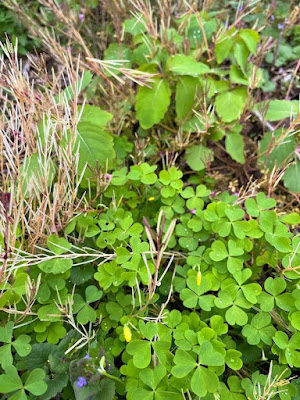News from the preserves, parks and backyards of Princeton, NJ. The website aims to acquaint Princetonians with our shared natural heritage and the benefits of restoring native diversity and beauty to the many preserved lands in and around Princeton.
Thursday, May 19, 2022
Weeds that Launch an Underground Insurgency
Sunday, May 08, 2022
Mother's Day's Complicated History With Flowers
Following the carnage of the Civil War, and before Anna Jarvis entered the scene, there had been efforts to celebrate mothers as a force in the world for peaceful settlement of differences, but none of the events had evolved into a tradition.
The death of Anna Jarvis's mother on the second Sunday in May, 1905, spurred Anna into action. Nine years of advocacy ultimately led to Woodrow Wilson's signature proclaiming an official Mother's Day in 1914, just in time for the outbreak of WWI several months later. Note the placement of the apostrophe. Rather than a celebration of mothers in general, Anna's vision was a very personal affair, in which people would give handwritten notes expressing gratitude for all that their own mothers had done for them. Anna distributed white carnations at the first formal Mother's Day event in 1908, but ultimately would spend the rest of her life fighting the commercialization of the day by the florist, card, and candy industries.
To honor the brave founder of the holiday, therefore, it looks like the best course of action would be to write a note of personal gratitude on something other than a Mother's Day gift card, perhaps accompanied by some flowers cut from the backyard. Lilacs, anyone? That could be followed by a stroll past some gardens with flowers in bloom.
Below are a random assortment of flowers that you might encounter, though the reader is to be discouraged from picking unless they are growing in your own yard.
A few from my own yard. This is Siberian bugloss, which is often confused withforget-me-nots, which are paler, less robust, and have much smaller leaves.Witch Alder (Fothergilla) is an attractive native shrub that I haven't seen growing naturally in our area but is available in nurseries.
These native azaleas, nurtured in the Barden at Herrontown Woods, have probably popped open by now. An experienced gardener sees the full bloom even in partially opened flowers.
Up at the Veblen House, where the flora shift from native towards English garden, people ask what these pretty white or blue flowers are that spread across the lawn. Ajuga--a member of the mint family. Some people call it bugleweed.
Ever seen these and wondered what they were? So have I. Fritillarias have persisted in the Veblen garden from at least the 1970s,
along with a few primrose.
Thursday, May 05, 2022
An Explosion of Spring Weeds
First step, photograph them and write about them, on the chance that others might too find themselves wading through a backyard full of weeds and wonder what they all are. Click on a photo to make it larger.
This one, the most ridiculously successful, is purple deadnettle. It's in the mint family, which you can tell by its square stem, but unlike many other mints, it relies on seeds to spread, rather than underground rhizomes.
Here's more purple deadnettle, with a foreground of ground ivy. Ground ivy has other names: creeping Charlie, and gill over the ground. It spreads vegetatively above ground, across lawns, into garden beds. It could be charming if it weren't so aggressive. The same can be said for mock strawberry.Here's the ground ivy mixed in with some white clover at the bottom of the photo. The white clover hasn't been a problem, but in some situations, it too can become a sprawling mass.Ground ivy looks like a wave here, rising out of the lawn and swamping the stonecrop Sedums. I really like the dandelions, until they go to seed, then not so much. If the soil is soft, gather all the basal leaves in your hand and give a slow, steady pull. Feed the leaves to your guinea pigs. Do people still have guinea pigs as pets?
By now, you'll recognize the ground ivy at the bottom of the photo, the purple dead nettle in the middle. Equally prevalent is hairy bittercress, which is the now brown plant in the upper left. A gardener feels a sense of defeat when, having delayed too long in pulling the hairy bittercress, its seeds come flying up at your face. It feels like mockery, the plant having successfully completed its life cycle and populated the ground with seeds for yet another year.
Mugwort, down there at the bottom, is a tough customer that has taken over many gardens, raingardens, and fields. Recurrent pulling has limited it to one place in my garden, but it spreads to form monocultures along the gas pipeline right of way along the Princeton ridge. Above and left in the photo is a kind of horsetail that has inculcated itself into one of the flower beds, probably planted decades ago by a previous owner.
it exploded this year and became, like so many problems in the world, too much of a good thing.
Curly dock is easy to undercut with a shovel.
Another weed that's here and there and can easily be pulled from wet ground is rough avens. To its left in the photo is a native weed called willow herb. Both of these look like they might generate attractive flowers, but don't quite generate enough show to be considered ornamental.
































